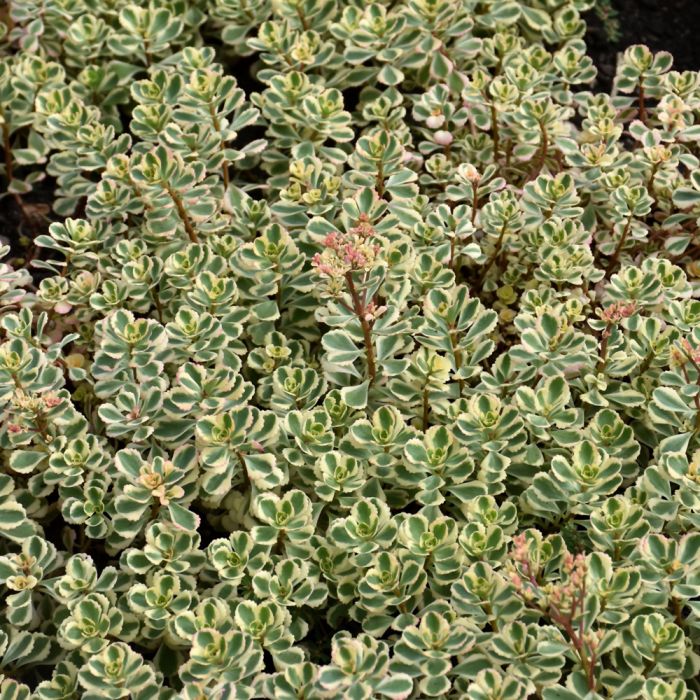Top Ten Drought Tolerant Plants
Our Crew members weighed in on their favorite drought tolerant plants.


Foliage emerges dark green with glowing gold edges, transforming to creamy white with pink highlights in summer. Very low, dense growth habit.
Discover an unparalleled selection of perennials at Gertens! With the largest variety in Minnesota, we offer endless options of colorful perennials, natives, and pollinator plants to beautify your garden year after year. From vibrant flowers to lush foliage, our perennials are perfect for adding beauty and charm to your outdoor space. Visit Gertens today and see why we're known as Minnesota's Destination Garden Center!
What A Doozie Stonecrop | Sedum spurium 'Spiraling Doozie'
Height: 5 inches
Spacing: 10 inches
Hardiness Zone: 5a
Brand: Darwin Perennials
Description:
Beautiful green leaves are edged in creamy white, before picking up rosy-pink hues in the late summer and fall; masses of rich pink blooms in late summer; this mat forming groundcover is ideal for the rock garden or the front of a sunny border
Ornamental Features
What A Doozie Stonecrop is smothered in stunning pink star-shaped flowers with creamy white overtones at the ends of the stems from late summer to mid fall. Its attractive tiny succulent round leaves remain green in color with distinctive white edges and tinges of pink throughout the year. The brick red stems are very colorful and add to the overall interest of the plant.
Landscape Attributes
What A Doozie Stonecrop is a dense herbaceous evergreen perennial with a ground-hugging habit of growth. It brings an extremely fine and delicate texture to the garden composition and should be used to full effect.
This plant will require occasional maintenance and upkeep, and is best cleaned up in early spring before it resumes active growth for the season. Deer don't particularly care for this plant and will usually leave it alone in favor of tastier treats. Gardeners should be aware of the following characteristic(s) that may warrant special consideration;
What A Doozie Stonecrop is recommended for the following landscape applications;
Planting & Growing
What A Doozie Stonecrop will grow to be only 5 inches tall at maturity, with a spread of 12 inches. When grown in masses or used as a bedding plant, individual plants should be spaced approximately 10 inches apart. Its foliage tends to remain low and dense right to the ground. It grows at a fast rate, and under ideal conditions can be expected to live for approximately 10 years. As an evegreen perennial, this plant will typically keep its form and foliage year-round.
This plant does best in full sun to partial shade. It prefers dry to average moisture levels with very well-drained soil, and will often die in standing water. It is considered to be drought-tolerant, and thus makes an ideal choice for a low-water garden or xeriscape application. Like most succulents and cacti, this plant prefers to grow in poor soils and should therefore never be fertilized. It is not particular as to soil pH, but grows best in poor soils, and is able to handle environmental salt. It is highly tolerant of urban pollution and will even thrive in inner city environments. This is a selected variety of a species not originally from North America. It can be propagated by division; however, as a cultivated variety, be aware that it may be subject to certain restrictions or prohibitions on propagation.
What A Doozie Stonecrop is a fine choice for the garden, but it is also a good selection for planting in outdoor pots and containers. Because of its spreading habit of growth, it is ideally suited for use as a 'spiller' in the 'spiller-thriller-filler' container combination; plant it near the edges where it can spill gracefully over the pot. Note that when growing plants in outdoor containers and baskets, they may require more frequent waterings than they would in the yard or garden. Be aware that in our climate, most plants cannot be expected to survive the winter if left in containers outdoors, and this plant is no exception. Contact our experts for more information on how to protect it over the winter months.
| Common Family Name | Sedum |
|---|---|
| Gerten Grown Plants | Gerten Grown Plants |
| Available for Pre-Order | Yes |
| Sun Preference | Full-Sun |
| Bloom Time | August, September |
| Mature Spread (Range) | 12" - 24" |
| Mature Height (Range) | 7-12" |
| USDA Hardiness Zone | 5, 6, 7, 8, 9 |